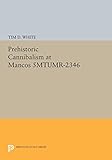Prehistoric Cannibalism at Mancos 5MTUMR-2346 / Tim D. White.
Material type: TextSeries: Princeton Legacy Library ; 132Publisher: Princeton, NJ : Princeton University Press, [2014]Copyright date: ©1992Edition: Course BookDescription: 1 online resource (488 p.)Content type:
TextSeries: Princeton Legacy Library ; 132Publisher: Princeton, NJ : Princeton University Press, [2014]Copyright date: ©1992Edition: Course BookDescription: 1 online resource (488 p.)Content type: - 9780691609034
- 9781400852925
- 978.8/27 20
- E99.P9
- online - DeGruyter
- Issued also in print.
| Item type | Current library | Call number | URL | Status | Notes | Barcode | |
|---|---|---|---|---|---|---|---|
 eBook
eBook
|
Biblioteca "Angelicum" Pont. Univ. S.Tommaso d'Aquino Nuvola online | online - DeGruyter (Browse shelf(Opens below)) | Online access | Not for loan (Accesso limitato) | Accesso per gli utenti autorizzati / Access for authorized users | (dgr)9781400852925 |
Frontmatter -- Contents -- Figures -- Tables -- Preface -- Acknowledgments -- CHAPTER 1. The Trail to Mancos -- CHAPTER 2. Cannibalism Past and Present -- CHAPTER 3. Cannibalism in the Prehistoric Southwest: Mancos 5MTUMR-2346 and Its Context -- CHAPTER 4. Analytical Background and Conjoining -- CHAPTER 5. The Mancos 5MTUMR-2346 Sample: A Biological Background -- CHAPTER 6. Method and Theory: Physical Anthropology Meets Zooarchaeology -- CHAPTER 7. The Head -- CHAPTER 8. The Thorax, Pelvis, and Shoulder Girdle -- CHAPTER 9. The Arm -- CHAPTER 10. The Leg -- CHAPTER 11. The Hand and Foot -- CHAPTER 12. Comparative Analysis -- CHAPTER 13. Evaluation -- Appendix 1. Catalog of Southwest Archaeological Sites with Evidence Interpreted as Indicating Cannibalism -- Appendix 2. Mancos 5MTUMR-2346 Human Bone Specimen Databases -- Appendix 3. Procedures for the Recovery and Analysis of Broken and Scattered Human Bone from Archaeological and Forensic Contexts -- Bibliography -- Index
restricted access online access with authorization star
http://purl.org/coar/access_right/c_16ec
Cannibalism is one of the oldest and most emotionally charged topics in anthropological literature. Tim White's analysis of human bones from an Anasazi pueblo in southwestern Colorado, site 5MTUMR-2346, reveals that nearly thirty men, women, and children were butchered and cooked there around A.D. 1100. Their bones were fractured for marrow, and the remains discarded in several rooms of the pueblo. By comparing the human skeletal remains with those of animals used for food at other sites, the author analyzes evidence for skinning, dismembering, cooking, and fracturing to infer that cannibalism took place at Mancos. As White evaluates claims for cannibalism in ethnographic and archaeological contexts worldwide, he describes how cultural biases can often distort the interpretation of scientific data. This book applies and introduces anatomical, taphonomic, zooarchaeological, and forensic methods in the investigation of prehistoric human behavior. It is an important example of how we can exchange opinion for knowledge. "Cannibalism is a controversial topic because many people do not want to believe that their prehistoric ancestors engaged in such activity, but they will be hard put to reject this meticulous study."--Kent V. Flannery, University of Michigan "This is the best piece of detailed research yet to appear that seeks to put in place a body of justified knowledge and a procedure for its use in making inferences about the past. No student of bones can ignore this work."--Lewis R. Binford, University of New Mexico "This could be one of the most important books in archaeology written in the last decade."--James F. O'Connell, University of Utah "Paleontologists and zooarchaeologists, archaeologists and physical anthropologists, taphonomists, and forensic scientists should all read this work. Quite frankly, I think this will become one of the most important books of the 1990s."--R. Lee Lyman, University of Missouri-ColumbiaOriginally published in 1992.The Princeton Legacy Library uses the latest print-on-demand technology to again make available previously out-of-print books from the distinguished backlist of Princeton University Press. These editions preserve the original texts of these important books while presenting them in durable paperback and hardcover editions. The goal of the Princeton Legacy Library is to vastly increase access to the rich scholarly heritage found in the thousands of books published by Princeton University Press since its founding in 1905.
Issued also in print.
Mode of access: Internet via World Wide Web.
In English.
Description based on online resource; title from PDF title page (publisher's Web site, viewed 30. Aug 2021)


